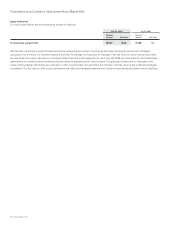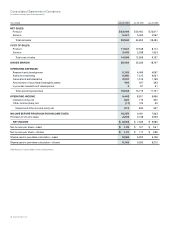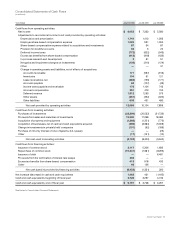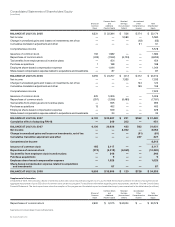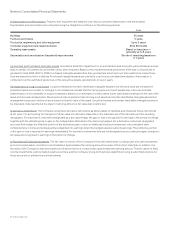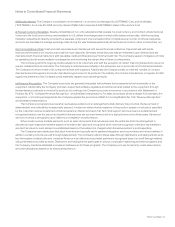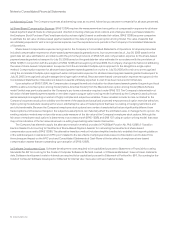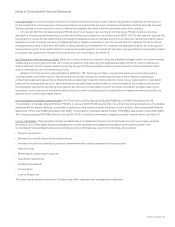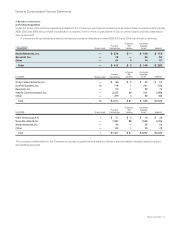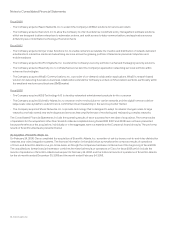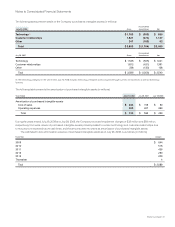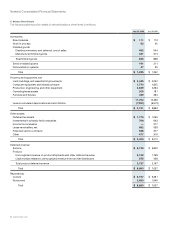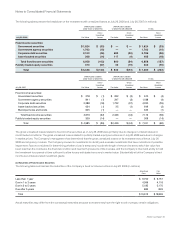Cisco 2008 Annual Report Download - page 50
Download and view the complete annual report
Please find page 50 of the 2008 Cisco annual report below. You can navigate through the pages in the report by either clicking on the pages listed below, or by using the keyword search tool below to find specific information within the annual report.
2008 Annual Report 55
Notes to Consolidated Financial Statements
(r) Income Taxes Income tax expense is based on pretax financial accounting income. Deferred tax assets and liabilities are recognized
for the expected tax consequences of temporary differences between the tax bases of assets and liabilities and their reported amounts.
Valuation allowances are recorded to reduce deferred tax assets to the amount that will more likely than not be realized.
On July 29, 2007, the Company adopted FIN 48, which is a change in accounting for income taxes. FIN 48 contains a two-step
approach to recognizing and measuring uncertain tax positions accounted for in accordance with SFAS 109. The first step is to evaluate the
tax position for recognition by determining if the weight of available evidence indicates that it is more likely than not that the position will be
sustained on audit, including resolution of related appeals or litigation processes, if any. The second step is to measure the tax benefit as
the largest amount that is more than 50% likely of being realized upon settlement. The Company will classify the liability for unrecognized
tax benefits as current to the extent that the Company anticipates payment (or receipt) of cash within one year. Interest and penalties related
to uncertain tax positions are recognized in the provision for income taxes. See Note 13.
(s) Computation of Net Income per Share Basic net income per share is computed using the weighted-average number of common shares
outstanding during the period. Diluted net income per share is computed using the weighted-average number of common shares and
dilutive potential common shares outstanding during the period. Dilutive potential common shares primarily consist of employee stock
options, restricted stock and restricted stock units.
Statement of Financial Accounting Standards (SFAS) No. 128, “Earnings per Share,” requires that employee equity share options,
unvested shares, and similar equity instruments granted by the Company be treated as potential common shares outstanding in
computing diluted earnings per share. Diluted shares outstanding include the dilutive effect of in-the-money options which is calculated
based on the average share price for each fiscal period using the treasury stock method. Under the treasury stock method, the amount
the employee must pay for exercising stock options, the amount of compensation cost for future service that the Company has not yet
recognized, and the amount of tax benefits that would be recorded in additional paid-in capital when the award becomes deductible are
assumed to be used to repurchase shares.
(t) Consolidation of Variable Interest Entities The Financial Accounting Standards Board (FASB) issued FASB Interpretation No. 46,
“Consolidation of Variable Interest Entities” (“FIN 46”), in January 2003. FIN 46 requires that if an entity is the primary beneficiary of a variable
interest entity, the assets, liabilities, and results of operations of the variable interest entity should be included in the consolidated financial
statements of the entity. FASB Interpretation No. 46(R), “Consolidation of Variable Interest Entities” (“FIN 46(R)”), was issued in December 2003.
The Company adopted FIN 46(R) effective January 24, 2004. For additional information regarding variable interest entities, see Note 10.
(u) Use of Estimates The preparation of financial statements and related disclosures in conformity with accounting principles generally
accepted in the United States requires management to make estimates and judgments that affect the amounts reported in the
Consolidated Financial Statements and accompanying notes. Estimates are used for the following, among others:
• Revenue recognition
• Allowance for doubtful accounts and sales returns
• Inventory valuation and liability for purchase commitments with contract manufacturers and suppliers
• Warranty costs
• Share-based compensation expense
• Investment impairments
• Goodwill impairments
• Income taxes
• Loss contingencies
The actual results experienced by the Company may differ materially from management’s estimates.



